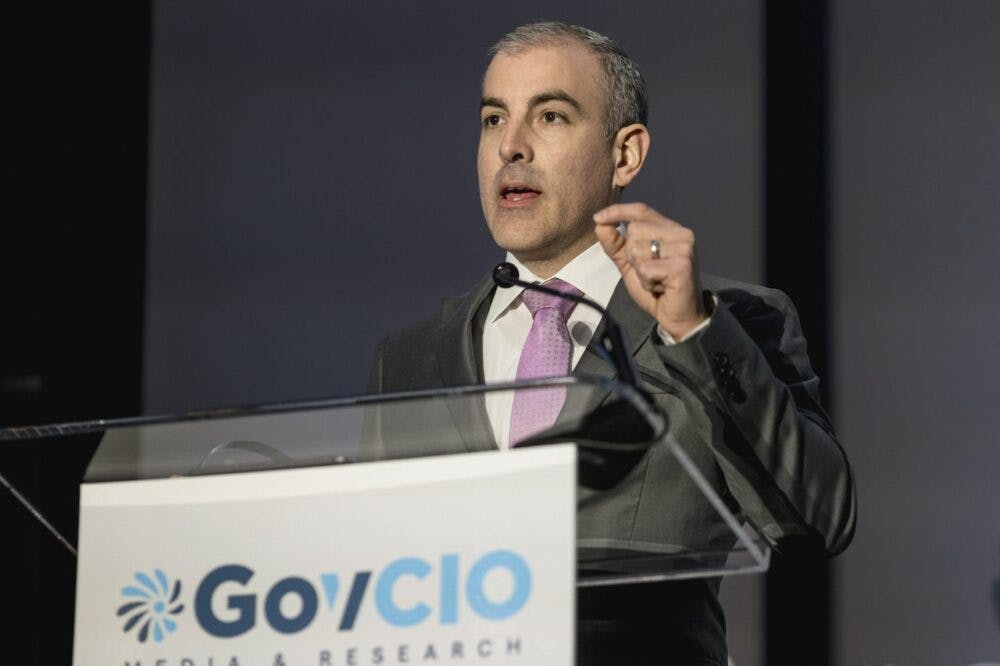How AI Can Help DOD Change Patient Outcomes On the Battlefield
AI and edge computing could help service members in combat zones endure through difficult circumstances.

Artificial Intelligence (AI) is one of the greatest areas of innovation in the Defense Department (DOD) medical field that could change patient outcomes in theater, according to Jesus Caban, chief of clinical and research informatics at the Walter Reed National Military Medical Center.
Service members in combat zones could often be days away from the nearest medical facility. In those instances, AI and edge computing capabilities can help save soldiers’ lives on the battlefield by enabling medics and other military service members to enter a data point, such as a picture of a gunshot wound or the type of injury the patient sustained, then get in touch with a “helper.” Based on the data entered, the “helper” can provide information about the kind of medical care the patient needs to receive.
“There are a lot of opportunities out there for us to be able to go and say ‘How are we leveraging devices at the point of injury, edge computing to be able to help — not the doctors — at that level are the corpsmen and the medics or the patient himself to stay alive for 24 hours, 36 hours into reaching a hospital,'” Caban said at the Red Hat Government Symposium Wednesday.
In the war in Ukraine, Ukrainian service members and allied partners are often days away from the nearest medical facility, making deployment of capabilities such as AI and edge computing critical for medics and patients on the ground.
“Unfortunately, when you don’t have air superiority, I think those things will happen,” Caban said. “Therefore, I think we need to be looking at those situations and saying, ‘Okay, how can edge computing, how predictive models that I have, how old the clinical data that I can have there, the environment, the sensors and so on will help to keep this patient alive. So I think that’s what we should be learning from these grim wars.”
DOD and the Department of Veterans Affairs (VA) researchers have also deployed AI and machine learning (ML) capabilities to understand and treat traumatic brain injury (TBI). Caban said that every active duty patient he has had since 1999 who sustained a brain injury is now in the registry, which includes around 510,000 patients.
With that data, researchers are now able to develop predictive models allowing doctors to understand the likelihood of developing mental health conditions.
“All the medical records have been standardized, and it’s in our registry, so maybe it’s some labs, medications, clinical notes, and so on. So then once we had that … now we need to start creating models to understand the likelihood of developing mental health conditions,” Caban said. “How many of them develop mental health conditions after having a concussion? Does it take six months to a year? When do they start developing those mental health conditions?”
Connecting patients’ data behind the VA firewall securely allows DOD and VA to conduct long-term analysis for the TBI programs with the help of AI and ML.
“I think AI methods are going to be essential to really understand the interconnections of diseases,” Dr. Mary Jo Pugh, VA research career scientist, told GovCIO Media & Research. “So you have the disease networks, and you can see that longitudinally with these longitudinal data. You can do a logistic regression with … typical methods, but you don’t see all of the interconnections. I’m not 100% positive, but I believe very strongly we’re going to see some interesting connections that we didn’t realize before.”
AI is also helping VA clinicians reduce administrative burdens and concentrate on treating patients instead.
“It’s true that there is no physician, clinician, psychologist who ever got into that field saying, ‘What I really want to do is fill out a bunch of forms, and I want to search through piles and piles of data to find what I really need,'” Amanda Purnell, director of data and analytics innovation at the Department of Veterans Affairs, said at the Red Hat Government Symposium.
This is a carousel with manually rotating slides. Use Next and Previous buttons to navigate or jump to a slide with the slide dots
-

Pentagon's $200M AI Contracts Signal Broader Effort to Transform Talent
The Army is leveraging Silicon Valley, reservist programs and new hiring strategies to integrate critical digital skills in its ranks.
5m read -

AI Foundations Driving Government Efficiency
Federal agencies are modernizing systems, managing risk and building trust to scale responsible AI and drive government efficiency.
43m watch -

Agencies Tackle Infrastructure Challenges to Drive AI Adoption
Federal agencies are rethinking data strategies and IT modernization to drive mission impact and operational efficiency as new presidential directives guide next steps.
5m read Partner Content -

Generative AI Demands Federal Workforce Readiness, Officials Say
NASA and DOI outline new generative AI use cases and stress that successful AI adoption depends on strong change management.
6m read -

The Next AI Wave Requires Stronger Cyber Defenses, Data Management
IT officials warn of new vulnerabilities posed by AI as agencies continue to leverage the tech to boost operational efficiency.
5m read -

Federal CIOs Push for ROI-Focused Modernization to Advance Mission Goals
CIOs focus on return on investment, data governance and application modernization to drive mission outcomes as agencies adopt new tech tools.
4m read -

Fed Efficiency Drive Includes Code-Sharing Law, Metahumans
By reusing existing code instead of rewriting it, agencies could dramatically cut costs under the soon-to-be-enacted SHARE IT Act.
5m read -

Trump Executive Order Boosts HBCUs Role in Building Federal Tech Workforce
The executive order empowers HBCUs to develop tech talent pipelines and expand access to federal workforce opportunities.
3m read -

Navy Memo Maps Tech Priorities for the Future Fight
Acting CTO’s memo outlines critical investment areas, from AI and quantum to cyber and space, as part of an accelerated modernization push.
5m read -

DOD Can No Longer Assume Superiority in Digital Warfare, Officials Warn
The DOD must make concerted efforts to address cyber vulnerabilities to maintain the tactical edge, military leaders said at HammerCon 2025.
4m read -

New NSF Program Cultivates the Future of NextG Networks
The agency’s new VINES program looks to tackle key challenges like energy efficiency and future-proofing wireless tech.
21m watch -

DHA CDAO Spearheads Master Data Catalog to Boost Transparency
Jesus Caban plans to boost DHA's data maturity through a new master data catalog, governance frameworks and inventory of tech tools.
5m read
















